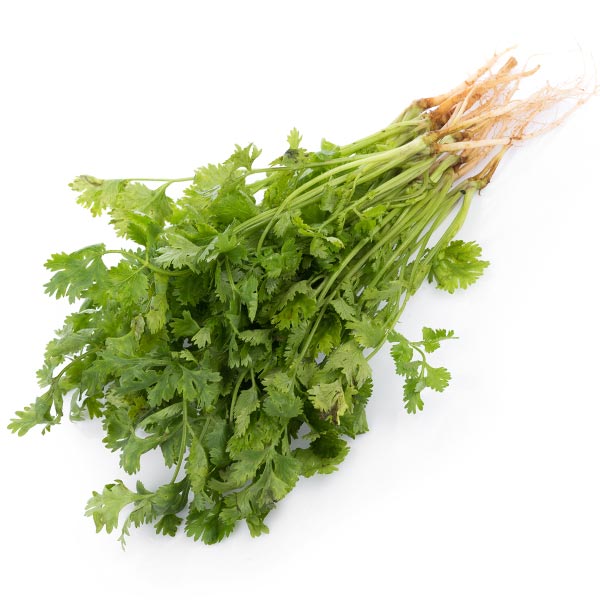Growing Cilantro/Coriander Herb Seed
- Latin name: Apiaceae Corriandrum
- Days to Maturity: Annual, begin harvesting after 3-4 weeks
- Other Names: Chinese Parsley, Dhania
- Planting Depth: ¼-1"
- Plant Spacing: 4-6”
- Growth Habit: Upright
- Soil Preference: Well-drained, somewhat granular soil
- Temp Preference: Cool
- Light Preference: Full sun, with periods of blotted shade
- Color: Green with white and light-pink flowers
- Flavor: Strong, fresh and zesty. Many claim cilantro tastes like dishsoap
- Misconceptions: Often confused with Culantro
- Availability: Buy Cilantro Herb Seed

>>> See Full Herb Grow Guide List <<<
Difference Between Cilantro and Coriander
Short answer: nothing. "Cilantro" is just Spanish for "Coriander". However, generally, "Cilantro" is used to refer to the greenery of the herb, the stem, leaves, and flowers. Whereas, "Coriander" is used to refer to the seeds themselves. You will see this distinction particularly in recipes and writings about cooking.
Difference Between Split and Non-split Varieties
The structure of a coriander seed is somewhat complex with a papery globular husk surrounding it. The true seed lies at the center. It is how cilantro seed protects itself in nature. Therefore, when planted whole in the garden, this husk extends germ time up to a week, taking up to a couple weeks in total to germinate. If you split the cilantro seed before planting, the seedling will emerge much quicker and with more ease.

Whole Coriander (left), Split Coriander (right)
Planting Cilantro Seeds
You can choose to direct sow cilantro outdoors in your garden bed or in a growing container two weeks passed the first frost of the year. You can opt for starting your cilantro seeds indoor 2 to 4 weeks before the first frost and transplant outdoors when temperatures are consistently above 60 degrees. Young plants will have to be hardened off so that cilantro doesn't get transplant shock. Germination takes 1-3 weeks, depending on whether you plant your coriander seeds whole or split.
Growing and Maintaining Cilantro Herb
Water in the mornings for best results, but don't overwater. Soil should be moist to the touch but not soggy. Cilantro grows rapidly. Within a few weeks of the seed's germination, you should seed serrated leaf foliage. This plant grows best in sun, but does benefit from slight shade, either with a shade cloth or planted in a place where it receives blotted sun at some point in the day. Overheating causes the plant to bolt. Water young plants consistently for best growth. Cilantro is known for having a short lifecycle, about 7 weeks. At which point, it seeks to flower and drop it's seeds.

Cilantro growing in a metal container in the garden.
For on-going cilantro herb harvests, plant cilantro every few weeks during the warm season, so that as one cilantro plant begins to end its lifecycle, another is just beginning.
Possible Cilantro Pests
Cilantro is known to have few pests because of its strong aromatic properties; however, aphids and whiteflies may appear. Gently remove by hand and/or with a soft steady stream of water.
Possible Cilantro Diseases
Leaf Spot - yellow spots on leaves that worsen into brown spots. Usually, it is a result of soil being too saturated with water, resulting in poor air circulation. To treat, stop watering until soil has dried a bit, giving the roots a chance to breathe a little.
Harvesting Cilantro
Leaves and Stems - Begin harvesting cilantro leaves after 3-4 weeks of growth. Cut back the cilantro frequently for controlled and continuous growth. This plant can be harvested 4-5 weeks from the time the seeds are planted. Letting some plants set seed and drop on their own will give you plants for next season. For long-term storage, cut the mature seed heads and store in a dry container, such as a paper bag.
Coriander Seeds - Allow the plant to produce lovely aromatic white and pink umbel flowers. Watch the seed pods form, green at first. Then as they dry out in the heat, the coriander pods begin to turn brown. At that point, cut the entire herb at the main stem and place in a large paper sack to dry for about a week.

Cilantro after flowering with seed pods.
What is Culantro?
Also known as Mexican Coriander, Long Cilantro, and Sawtooth Coriander, Culantro (Eryngium foetidum) is a perennial native to the tropical regions of the Americas. Although a relative of cilantro, belonging to the Apiacaeae family, it is an altogether different plant. The appearance of culantro is very difference from typical cilantro with long serrated leaves; however, it is used as a cilantro replacement in Mexican cuisine.
Explore these Cilantro Herb Seed Varieties:











